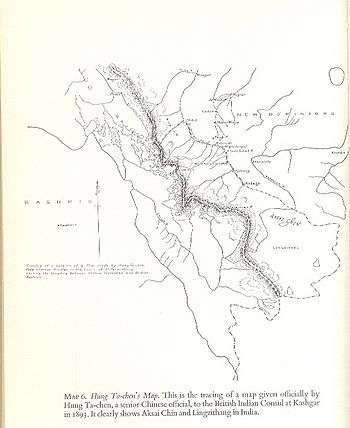Macartney–MacDonald Line


The Macartney–MacDonald Line is a proposed boundary in the disputed area of Aksai Chin.
William Johnson, a civil servant with the Survey of India proposed the "Johnson Line" in 1865, which put Aksai Chin in Kashmir. In 1893, Hung Ta-chen, a senior Chinese official at Kashgar, handed a map of the boundary proposed by China to George Macartney, the British consul-general at Kashgar.[1] This boundary placed the Lingzi Tang plains, which are south of the Laktsang range, in India, and Aksai Chin proper, which is north of the Laktsang range, in China. Macartney agreed with the proposal and forwarded it to the British Indian government.[2] The British presented this line, known as the Macartney–MacDonald line, to the Chinese in a note by Sir Claude MacDonald.[2] The Qing government did not respond to the note, and the British took that as Chinese acquiescence. Although no official boundary had ever been negotiated, China believed that this had been the accepted boundary.[2][3] The Macartney–MacDonald Line had been tacitly accepted by China [3] as the boundary until Chinese Premier Zhou Enlai confirmed the new Chinese claim line to his Indian counterpart, Jawaharlal Nehru in 1959.
The Macartney–MacDonald Line is a partial basis of the Sino-Pakistan Agreement. It has been suggested that a solution to the Sino-Indian border dispute could also be based on the Macartney–MacDonald Line.[3][4]
The Macartney–MacDonald line is described as follows:
"From the Karakoram Pass the crests of the range run nearly east for about half a degree, and then turn south to a little below the 35th parallel.. Rounding... the source of the Karakash, the line of hills to be followed runs north-east to a point east of Kizil Jilga and from there, in a south-easterly direction, follows the Lak Tsung (Lokzhung) Range until that meets a spur.. which has hitherto been shown on our maps as the eastern boundary of Ladakh."[2]
References
- ↑ Woodman, Dorothy (1969). Himalayan Frontiers. London: Barrie & Rockliff, The Cresset Press.
- 1 2 3 4 Calvin, James Barnard (April 1984). "The China-India Border War". Marine Corps Command and Staff College. Retrieved 14 October 2011.
- 1 2 3 Verma, Colonel Virendra Sahai. "Sino-Indian Border Dispute At Aksai Chin - A Middle Path For Resolution" (PDF). Retrieved 28 August 2013.
- ↑ http://www.outlookindia.com/article.aspx?282579